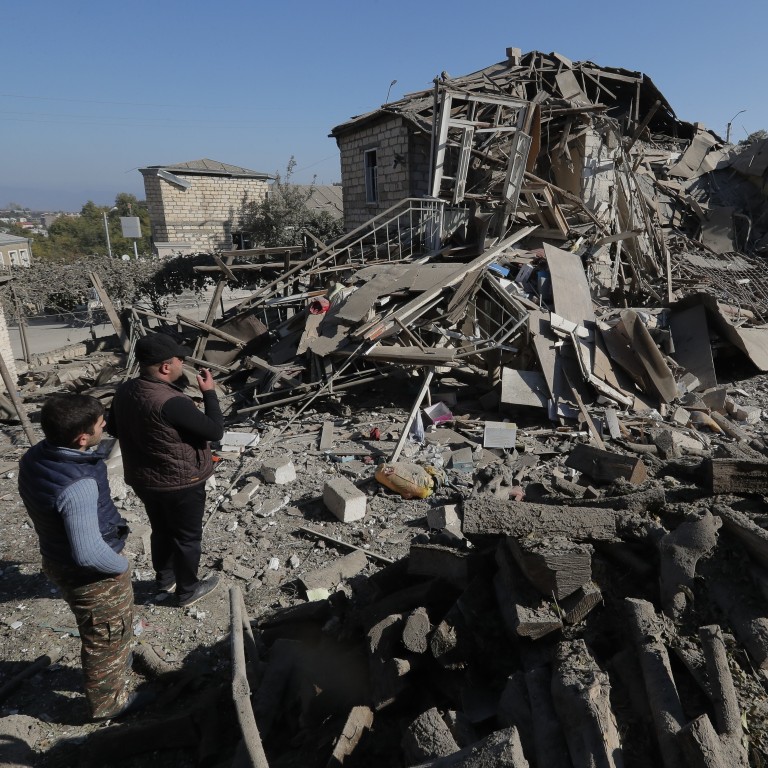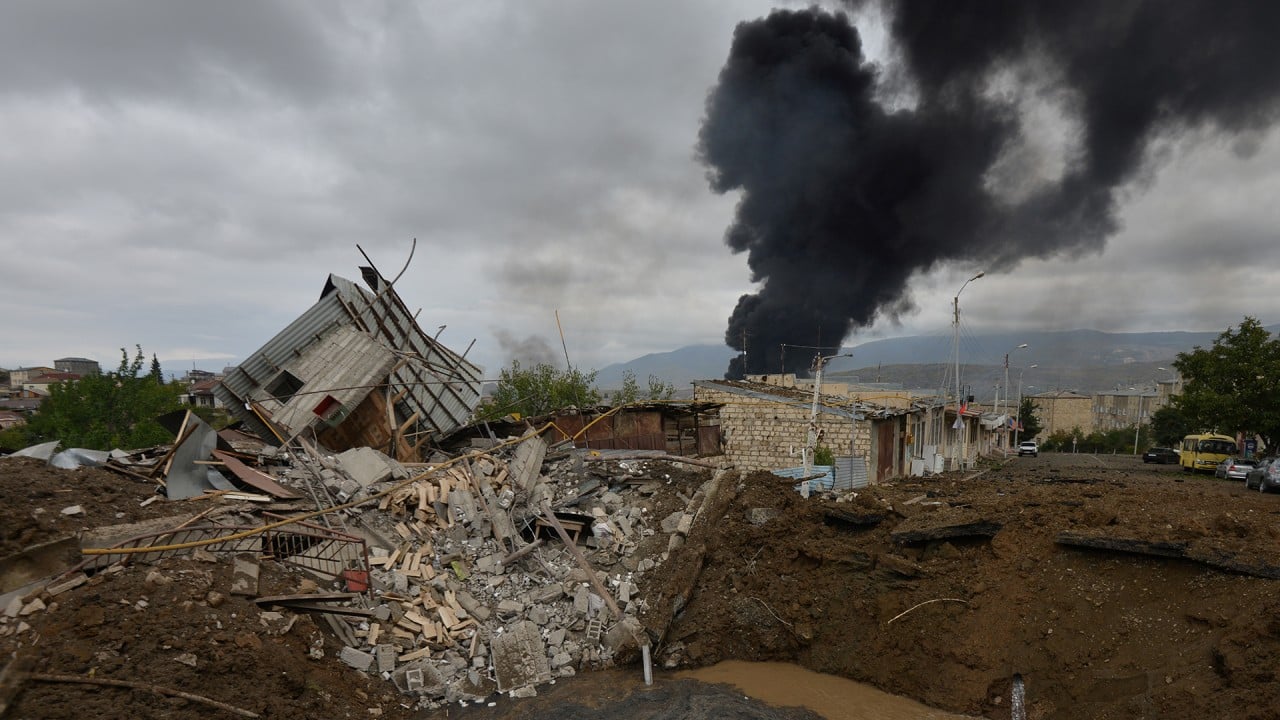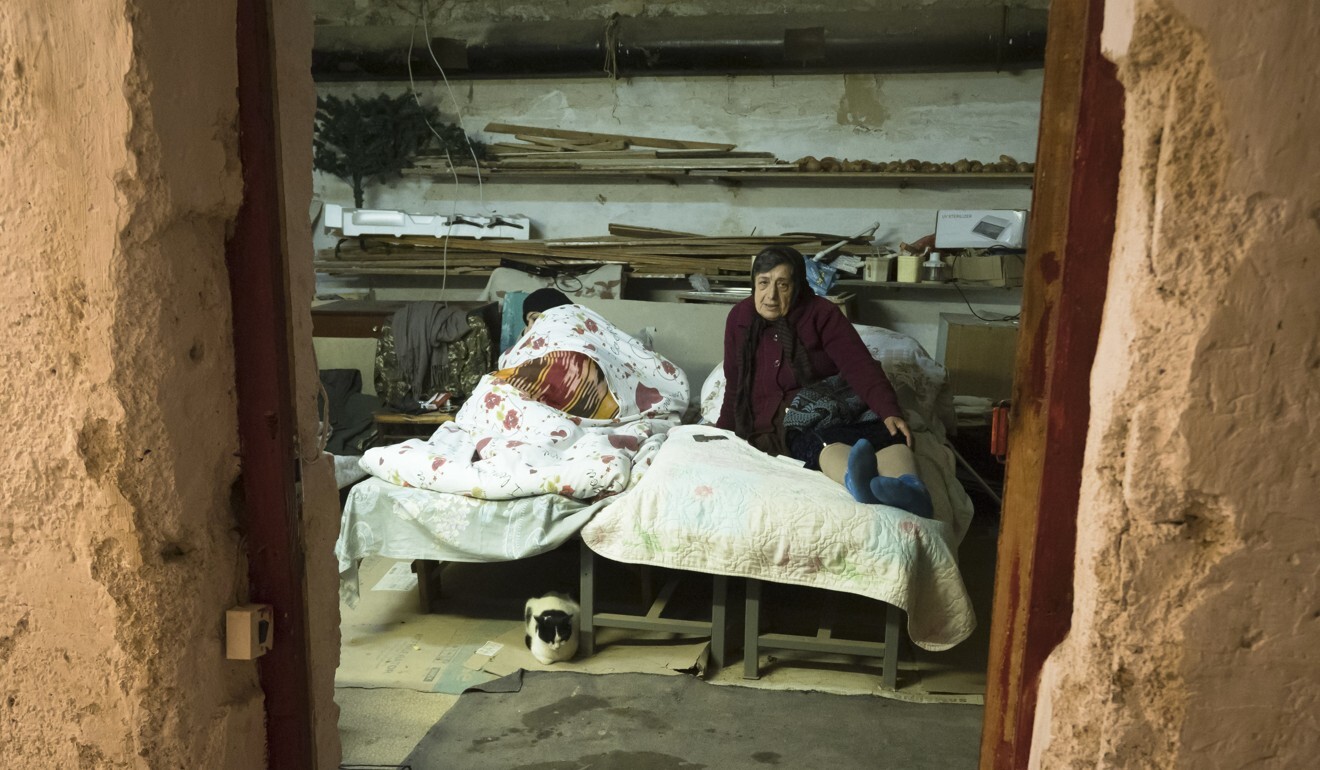
Azerbaijan’s president vows revenge after missile strike in Ganja kills at least 12 civilians
- The strike came only hours after the Nagorno-Karabakh capital Stepanakert underwent a shelling attack
- Rescuers called for silence so that they could detect sounds of survivors after a building was reduced to rubble
Azerbaijan’s President Ilham Aliyev vowed on Saturday to strike back against Armenia after shelling on his country’s second largest city Ganja left at least 12 civilians dead and dozens injured.
Aliyev said Azerbaijan’s army would retaliate against Armenia and “take revenge on the battlefield”, in televised remarks hours after the shelling on a residential area in Ganja flattened rows of houses.
The missile strike marks a sharp escalation of the conflict over the disputed Nagorno-Karabakh region.
The early hours attack, which saw a second missile strike another part of Ganja and a third reach the nearby strategic city of Mingecevir, came hours after Azerbaijani forces shelled the ethnic Armenian separatist region’s capital Stepanakert.
The seeming tit-for-tat attacks further undermines international efforts to calm a resurgence of fighting between Christian Armenians and Muslim Azerbaijanis before it draws in regional powers Russia and Turkey.
Rows of houses turned to rubble by the strike, which shattered the walls and ripped the roofs off buildings in the surrounding streets. People ran outside in shock and tears, stumbling through dark muddy alleys in their slippers, some wearing bathroom robes and pyjamas.

03:23
Azerbaijan and Armenia accuse each other of targeting cities outside conflict zones
The attack came only six days after a missile struck another residential part of the city of more than 300,000 people, killing 10 civilians and leaving many on edge.
At the scene of the latest strike, exploding shells rumbled in the distance as rescuers and red helmets used sniffer dogs to search for signs on life.
“We were sleeping. The kids were watching TV,” Rubaba Zhafarova, 65, said in front of her destroyed home.
“All the houses around here are destroyed. Many people are under the rubble. Some are dead, some are wounded.”
Hikmat Hajiyev, an assistant to Azerbaijan President Ilham Aliyev, tweeted that according to “initial information, more than 20 houses were destroyed” on Saturday.
Nagorno-Karabakh’s military said Azerbaijani forces had stepped up their attacks on Friday across the front, shelling Stepanakert and the nearby town of Susi.
The separatists “carried out equivalent operations to stop adversary fire,” they said in a statement released by the Armenian government.
Explosions rock Nagorno-Karabakh hours after ceasefire put in place
Rescuers periodically called for silence so they could hear the sounds of survivors as the hours passed, pulling passports, keys, bracelets and items of clothing from the debris.
They called in sniffer dogs and watered down the suffocating columns of dust with hosepipes from a fire truck.
“One woman was missing her feet. Someone else was missing an arm at the elbow,” said Elmir Shirinzaday, 26, in a visible state of shock.
Rescuers struggled to lift heavy boulders of rubble in search for signs of life, periodically taking breaks to try and calm distraught victims.
“My wife was there, my wife was there,” one man cried inconsolably while being walked toward an ambulance by a paramedic.

At around the same time in the city of Mingecevir, an hour’s drive north of Ganja, AFP heard the impact of a huge blast that shook buildings.
Mingecevir is protected by a missile defence system because it is home to a strategic dam, and it was not immediately clear if the missile was destroyed in the air or had made impact.
The defence ministry said Mingecevir had come “under fire”, but provided no other immediate details.
An Azerbaijani official said that another missile hit a separate, industrial district of Ganja at around the same time.
There were no immediate details about that attack.
Armenian and Azerbaijani forces resume fighting in Nagorno-Karabakh
The decades-long Nagorno-Karabakh conflict re-erupted on September 27 and has so far killed more than 700 people, including nearly 80 civilians.
The mountainous western region of Azerbaijan has remained under separatist Armenian control since a 1994 ceasefire ended a brutal war that killed 30,000.
Armenia, which backs Nagorno-Karabakh but does not recognise its independence, has admitted that Azerbaijani forces have made important gains along the front in the past week.

The current escalation is the deadliest and longest since that six-year conflict.
The shelling of Stepanakert and the strikes on the two Azerbaijani cities followed a joint call from Russian President Vladimir Putin and Turkish President Recep Tayyip Erdogan on Wednesday to “end the bloodshed as soon as possible”.
The rescuers called for silence so that they could detect sounds of survivors, and pulled out passports, unopened delivery packages and items of clothing from the debris.
One resident said the residential block was home to more than 20 people. Another said he saw a small child, two women and four men pulled from the rubble, although their state was not immediately clear.

.png?itok=arIb17P0)